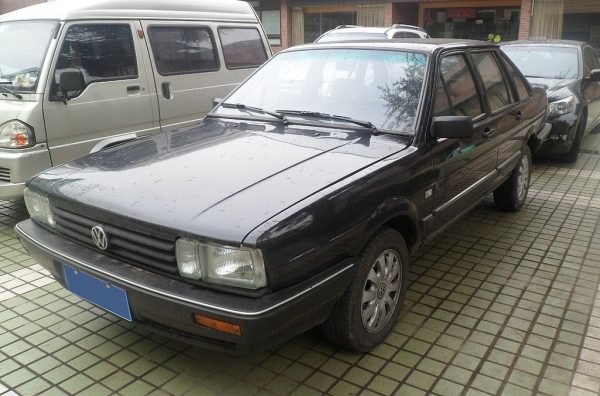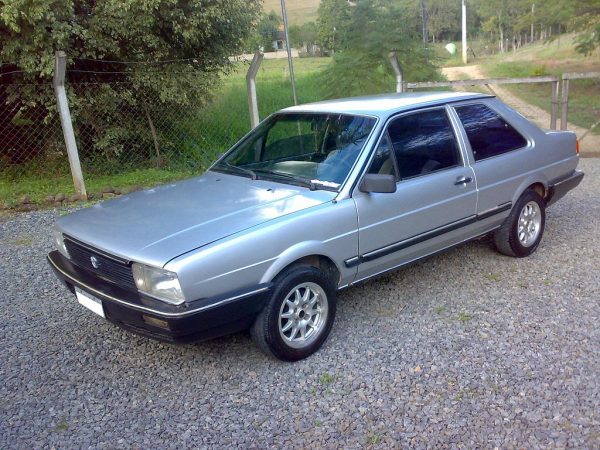
Volkswagen Santana: model history, tuning, owner reviews
Content
Volkswagen Santana, born in Germany, was able to conquer almost half the world very quickly. In different countries, he was known under many different names, but one thing remained unchanged - the German quality. This is probably why the car has, in fact, gone through several reincarnations - they can’t refuse the Volkswagen Santana.
Model range overview
Volkswagen Santana is the younger brother of the second generation Passat (B2). The car was first presented to the public in 1981, and in 1984 its mass production began.
The car was intended primarily for the South American and Asian market. It is noteworthy that in different countries he received different names. So, in the USA and Canada it was known as Quantum, in Mexico - as Corsar, in Argentina - Carat, and only in Brazil and a number of countries in South America it was remembered exactly as Volkswagen Santana. Until 1985, such a name existed in Europe, but then it was decided to abandon it in favor of the Passat.
Volkswagen Santana (China)
In China, "Santana" gained, perhaps, the greatest popularity, and it happened very rapidly: in 1983, the first such car was assembled here, and already in 1984, a joint German-Chinese venture, Shanghai Volkswagen Automotive, was created.

Initially, the unpretentious sedan was produced with a 1,6-liter gasoline engine; since 1987, the line of engines has been replenished with a 1,8-liter unit, also gasoline. Such motors worked in tandem with a four-speed gearbox. Cars with a 1,6-liter engine were distinguished by increased reliability and performance, and therefore were very fond of taxi drivers. In these modifications, the car was available until 2006.
Despite the remoteness from the German homeland, where all the technical miracles of that time were performed, the Chinese Santanas boasted many innovations, including the Bosch electronic injection system and ABS with electronic brake force distribution.
In 1991, the Santana 2000 arrived in China, and mass production began in 1995. Around the same time, she reached Brazil. The Chinese "Santana" from the Brazilian "sister" was distinguished by a longer - 2 mm - wheelbase.

In 2004, the Santana 3000 appeared. The car is distinguished from its predecessors by generally smoother lines; at the same time, the volume of the rear part has increased - the trunk looks more massive; hatch appeared. The car was initially available with the same 1,6 and 1,8 liter petrol engines; in 2006, a two-liter unit appeared.

In 2008, "Santana" "reincarnated" in the Volkswagen Vista - it can be recognized by the mesh grille, chrome moldings and taillights with circular elements.
Table: Volkswagen Santana specifications for China
| Santana | santana 2000 | santana 3000 | Vista | |
| Body type | 4-door sedan | |||
| Engine | 4-stroke, SOHC | |||
| Length, mm | 4546 | 4680 | 4687 | 4687 |
| Width | 1690 | 1700 | 1700 | 1700 |
| Height, mm | 1427 | 1423 | 1450 | 1450 |
| Weight, kg | 1030 | 1120 | 1220 – 1248 Feet | 1210 |
Nissan Santana (Japan)
In Japan, the German automaker found a reliable friend in the person of the president of Nissan, Takashi Ishihara, and in 1984 the island country began production of the Santana, albeit under the Nissan brand. Nissan Santana was available with three engine options - 1,8 and 2,0 petrol, generating 100 and 110 hp. respectively, as well as with a 1,6 turbodiesel with 72 hp. All engines worked with a five-speed “mechanics”, and a three-speed “automatic” was available for gasoline units.
Externally, the Japanese "Santana" was distinguished by a special grille and headlights. In addition, the Nissan Santana was 5mm narrower than its German counterparts to avoid the Japanese tax on vehicles over 1690mm wide.
In May 1985, an Autobahn version of the Xi5 was added to the lineup, gaining sports seats, sunroofs and 14" alloy wheels. In January 1987, a facelift was carried out, due to which Santana received more massive bumpers.
The production of Nissan Santana cars in Japan ceased in 1991 - the German auto giant "changed" Nissan with Toyota.
Volkswagen Santana (Brazil)
The German car reached Brazil in 1984. Here it was presented in a large number of modifications - a sedan with four and two doors, as well as a Quantum station wagon. Brazilian Santanas were equipped with 1,8 or 2 liter engines that could run on gasoline or ethanol (!). At first, all power units were paired with a four-speed manual gearbox; since 1987, modifications with a five-speed gearbox have become available.

Table: Volkswagen Santana Specifications for Brazil
| Length, mm | 4600 |
| Width | 1700 |
| Height, mm | 1420 |
| Wheelbase, mm | 2550 |
| Weight, kg | 1160 |
In 1991, the Brazilian division of Volkswagen launched a joint venture with Ford. However, instead of developing a radical new replacement for the Passat (B2), it was decided to take the path of less resistance and rebuild the Santana. The body frame, trunk line, etc. were changed, which allowed the car to acquire a more modern look. The new Santana was sold in Brazil as the Ford Versailles and as the Ford Galaxy in Argentina.
Production of "Santana" in Brazil was finally curtailed in 2002.
Volkswagen Corsar (Mexico)
Santana, which received the name Corsair in the new homeland, arrived in the Mexican market in 1984. In Mexico, the Corsair was intended to be an affordable luxury and compete not with mid-range models, but with luxury like the Chrysler LeBaron "K", Chevrolet Celebrity, Ford Grand Marquis.

The Corsair was equipped with a 1,8-liter engine with 85 hp, paired with a four-speed manual transmission. Outwardly, the “Mexican” looked more like its European counterpart than American models. Externally, the "Corsair" was distinguished by four square headlights, 13-inch alloy wheels; the interior was upholstered in blue or gray velor; there was a cassette player, alarm system, power steering.
In 1986, the Corsair was updated - the radiator grille changed, electric mirrors and a black leather interior became available as an option. On the technical side, a five-speed manual transmission was added.
In 1988, the production of "Corsairs" in Mexico stopped in sync with the suspension of production of the "Santana" model in Europe. However, in the Latin American country people still enjoy driving the Corsairs, noting that this is not only a reliable, but also a status car.
Volkswagen Carat (Argentina)
Santana received a new incarnation in Argentina, where she reached in 1987; here she became known as "Karat". Here, as in most American markets, it was equipped with a 1,8 or 2-liter gasoline engine, which was paired with a five-speed “mechanics”. Of the technical innovations, the Karat had an independent front suspension, air conditioning, power windows. However, car production in Argentina ended in 1991.
Table: characteristics of the Volkswagen Santana (Carat) modification for Argentina
| 1,8 l engine | 2,0 l engine | |
| Power, hp | 96 | 100 |
| Fuel consumption, l per 100 km | 10 | 11,2 |
| Max. speed km / h | 168 | 171 |
| Length, mm | 4527 | |
| Width | 1708 | |
| Height, mm | 1395 | |
| Wheelbase, mm | 2550 | |
| Weight, kg | 1081 | |
New Santana
October 29, 2012 in Wolfsburg, Germany, the Volkswagen New Santana was introduced, designed for the Chinese market and designed to compete with Skoda Rapid, Seat Toledo and Volkswagen Jetta.

Silhouette, especially in profile to the trunk, the new "Santana" is similar to the "Skoda Rapid". The interior of the new "Santana" is distinguished by thoughtful design and ergonomics. In addition, even in the base, the car has airbags, not only in front, but also on the sides, air conditioning and even parking sensors.
The new "Santana" is available with two options for gasoline engines - 1,4 and 1,6 liters, power - 90 and 110 hp. respectively. It is noteworthy that the younger engine consumes only 5,9 liters of fuel per 100 km in mixed mode, and the older one - 6 liters. Both are paired with a five-speed manual transmission.
Tuning Volkswagen Santana
In fact, there are no spare parts directly for Volkswagen Santana on the Russian market - only spare parts from parsing. "Santana", as they say, "collective farms", using for this purpose suitable spare parts from the third "Golf" or "Passat" (B3).

The most common tuning option is an understatement. The average price of suspension springs is 15 thousand rubles. Also on the car you can install spoilers, dual exhaust, "glasses" on the front lights.
Video: tuning "Volkswagen Santana"
Connoisseurs lean towards retro tuning, perhaps updating the image of the car with chrome moldings, etc.
For the new "Santana" there are more tuning options - these are "eyelashes" on the headlights, an air intake on the hood, alternative taillights and mirrors, and much more.
Prices
In Russia, the old "Santana" remained mainly in small towns. Initially, a rather rare car, the Santana is not in special demand on the main car sales sites - as of January 2018, only half a dozen of these cars are sold throughout the country. Average price for a car 1982–1984 with a mileage of 150 to 250 thousand km - about 30-50 thousand rubles. It is noteworthy that most of the cars are still running.
Owner feedback
The attitude towards the old "Santans" is eloquently evidenced by the nicknames that their owners give them on Drive2 - "tube sluggish", "peppy Fritz", "workhorse", "peppy old man", "silver assistant".
"Santanas", as a rule, are either inherited by their owners or from comrades who have "grown" from such machines, or are bought for restoration. Car owners are mostly faced with a lack of spare parts. Sometimes one "Santana" on the go is three donor cars. The body of the Santana is very durable, practically resistant to corrosion, the engine has a long resource - many cars still drive around the country the way they came off the assembly line.
The device was super, never failed, sold after deprivation. The carburetor was redone on the VAZ from the eight. The body is indestructible, it looks like zinc, but there were problems with spare parts in appearance.
Good and faithful horse) Never let down on the road, quietly rides long distances. If it breaks down near the house) And so it travels an average of 25 kilometers a year.
I bought this car at the beginning of summer, somewhere in early June 2015. Took under restoration. The original idea was to make a classic, but then it was reborn into a sport. The engine pleases, byry and frisky. The body is in perfect condition.
Volkswagen Santana is a car that, for more than 30 years of operation in different countries and probably not in the best conditions, has proven itself to be a true workhorse. The Santana is a good option both for business and for the soul: even an age car can easily run on the roads for another ten years, and if you put a little love and effort into the Santana, you get a unique and representative retro car that will undoubtedly attract attention and please the eye of even the most demanding motorist.

